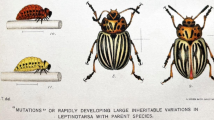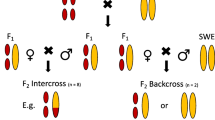Abstract
In this study, we attempted to elucidate the two resistance factors conferring resistance to organophosphates within the Katsunuma population of Drosophila melanogaster (Meigen), one of which has been mapped on the second chromosome and the other on the third chromosome. With regard to the second chromosome factor, we tested susceptibility to malathion of 54 recombinant inbred lines with recombination between ltd and vg. Analyses of variance (ANOVAs) showed highly significant variation in susceptibility to malathion between recombinant lines. In addition, susceptibility of the second-chromosome resistant line to malathion was increased with additional application of piperonyl butoxide, suggesting a member of the Cyp gene family located between ltd and vg. With regard to the third-chromosome factor, we conducted inhibition assays of acetylcholinesterase (AChE) with respect to fenitroxon and carbaryl, to evaluate the contribution of mutated AChE to organophosphate resistance within the Katsunuma population. I 50 values of resistant lines, isolated from this population, were about 15 times higher for fenitroxon, and about two times higher for carbaryl, than those of susceptible lines, suggesting the contribution of mutated AChE to organophosphate resistance within the Katsunuma population. We further investigated the genetic variation in the acetylcholinesterase (Ace) gene within the newly collected Katsunuma population, by using the allele-specific polymerase chain reaction (PCR) approach, and revealed that within this population there were high frequencies of resistant-type mutations at three sites in the Ace gene, which play critical roles in altering sensitivity of AChE to organophosphate and carbamate insecticides.



Similar content being viewed by others
References
Amichot M, Tarès S, Brun-Barale A, Arthaud L, Bride J-M, Bergé J-B (2004) Point mutations associated with insecticide resistance in the Drosophila cytochrome P450 Cyp6a2 enable DDT metabolism. Eur J Biochem 271:1250–1257. doi:10.1111/j.1432-1033.2004.04025.x
Ayyadevara S, Thaden JJ, Shmookler Reis RJ (2000) Discrimination of primer 3′-nucleotide mismatch by Taq DNA polymerase during polymerase chain reaction. Anal Biochem 284:11–18. doi:10.1006/abio.2000.4635
Bernard CB, Philogène BJR (1993) Insecticide synergists: role, importance, and perspectives. J Toxicol Environ Health 38:199–223
Bingham G, Gunning RV, Delogu G, Borzatta V, Field LM, Moores GD (2008) Temporal synergism can enhance carbamate and neonicotinoid insecticidal activity against resistant crop pests. Pest Manag Sci 64:81–85. doi:10.1002/ps.1477
Brandt A, Scharf M, Pedra JHF, Holmes G, Dean A, Kreitman M, Pittendrigh BR (2002) Differential expression and induction of two Drosophila cytochrome P450 genes near the Rst(2)DDT locus. Insect Mol Biol 11:337–341. doi:10.1046/j.1365-2583.2002.00344.x
Crow JF (1957) Genetics of insect resistance to chemicals. Annu Rev Entomol 2:227–246. doi:10.1146/annurev.en.02.010157.001303
Daborn P, Boundy S, Yen J, Pittendrigh B, ffrench-Constant R (2001) DDT resistance in Drosophila correlates with Cyp6g1 over-expression and confers cross-resistance to the neonicotinoid imidacloprid. Mol Genet Genomics 266:556–563. doi:10.1007/s004380100531
Daborn PJ, Yen JL, Bogwitz MR, Le Goff G, Feil E, Jeffers S, Tijet N, Perry T, Heckel D, Batterham P, Feyereisen R, Wilson TG, ffrench-Constant RH (2002) A single P450 allele associated with insecticide resistance in Drosophila. Science 297:2253–2256. doi:10.1126/science.1074170
Daborn PJ, Lumb C, Boey A, Wong W, ffrench-Constant RH, Batterham P (2007) Evaluating the insecticide resistance potential of eight Drosophila melanogaster cytochrome P450 genes by transgenic over-expression. Insect Biochem Mol Biol 37:512–519
Ellman GL, Courtney KD, Andres V Jr, Featherstone RM (1961) A new and rapid colorimetric determination of acetylcholinesterase activity. Biochem Pharmacol 7:88–95. doi:10.1016/0006-2952(61)90145-9
Festucci-Buselli RA, Carvalho-Dias AS, de Oliveira-Andrade M, Caixeta-Nunes C, Li H-M, Stuart JJ, Muir W, Scharf ME, Pittendrigh BR (2005) Expression of Cyp6g1 and Cyp12d1 in DDT resistant and susceptible strains of Drosophila melanogaster. Insect Mol Biol 14:69–77. doi:10.1111/j.1365-2583.2005.00532.x
ffrench-Constant RH, Daborn PJ, Le Goff G (2004) The genetics and genomics of insecticide resistance. Trends Genet 20:163–170. doi:10.1016/j.tig.2004.01.003
FlyBase Consortium (2003) The FlyBase database of the Drosophila genome projects and community literature. Nucleic Acids Res 31:172–175. doi:10.1093/nar/gkg094
Fournier D (2005) Mutations of acetylcholinesterase which confer insecticide resistance in insect populations. Chem Biol Interact 157:257–261
Hatano Y, Inoue Y, Watada M, Akai SM, Watanabe TK, Yamamoto M-T, Hirai K, Takegawa H, Itoh M (1999) Further genetic studies on the Katsunuma population of Drosophila melanogaster. Genes Genet Syst 74:219–225. doi:10.1266/ggs.74.219
Hemingway J, Hawkes NJ, McCarroll L, Ranson H (2004) The molecular basis of insecticide resistance in mosquitoes. Insect Biochem Mol Biol 34:653–665. doi:10.1016/j.ibmb.2004.03.018
Hughes KA (1995) The inbreeding decline and average dominance of genes affecting male life-history characters in Drosophila melanogaster. Genet Res 65:41–52
Kent WJ (2002) BLAT—The BLAST-like alignment tool. Genome Res 12:656–664. doi:10.1101/gr.229202
Khot AC, Bingham G, Field LM, Moores GD (2008) A novel assay reveals the blockade of esterases by piperonyl butoxide. Pest Manag Sci 64:1139–1142. doi:10.1002/ps.1603
Kono Y, Tomita T (2006) Amino acid substitutions conferring insecticide insensitivity in Ace-paralogous acetylcholinesterase. Pestic Biochem Physiol 85:123–132
Kuruganti S, Lam V, Zhou X, Bennett G, Pittendrigh BR, Ganguly R (2007) High expression of Cyp6g1, a cytochrome P450 gene, does not necessarily confer DDT resistance in Drosophila melanogaster. Gene 388:43–53. doi:10.1016/j.gene.2006.09.019
Le Goff G, Boundy S, Daborn PJ, Yen JL, Sofer L, Lind R, Sabourault C, Madi-Ravazzi L, ffrench-Constant RH (2003) Microarray analysis of cytochrome P450 mediated insecticide resistance in Drosophila. Insect Biochem Mol Biol 33:701–708. doi:10.1016/S0965-1748(03)00064-X
Li X, Schuler MA, Berenbaum MR (2007) Molecular mechanisms of metabolic resistance to synthetic and natural xenobiotics. Annu Rev Entomol 52:231–253. doi:10.1146/annurev.ento.51.110104.151104
Lindsley D, Zimm GG (1992) The genome of Drosophila melanogaster. Academic Press, San Diego
Lynch M, Walsh B (1998) Genetics and analysis of quantitative traits. Sinauer, Sunderland
Mamiya A, Ishikawa Y, Kono Y (1997) Acetylcholinesterase in insecticide resistant Culex tritaeniorhynchus: characteristics accompanying insensitivity to inhibitors. Appl Entomol Zool 32:37–44
Menozzi P, Shi MA, Lougarre A, Tang ZH, Fournier D (2004) Mutations of acetylcholinesterase which confer insecticide resistance in Drosophila melanogaster populations. BMC Evol Biol 4:4. doi:10.1186/1471-2148-4-4
Miyo T, Charlesworth B (2004) Density-independent population projection trajectories of chromosome-substituted lines resistant and susceptible to organophosphate insecticides in Drosophila melanogaster. BMC Genet 5:31
Miyo T, Oguma Y (2002) Negative correlations between resistance to three organophosphate insecticides and productivity within a natural population of Drosophila melanogaster (Diptera: Drosophilidae). J Econ Entomol 95:1229–1238
Miyo T, Akai S, Oguma Y (2000) Seasonal fluctuation in susceptibility to insecticides within natural populations of Drosophila melanogaster: empirical observations of fitness costs of insecticide resistance. Genes Genet Syst 75:97–104. doi:10.1266/ggs.75.97
Miyo T, Takamori H, Kono Y, Oguma Y (2001) Genetic variation and correlations among responses to five insecticides within natural populations of Drosophila melanogaster (Diptera: Drosophilidae). J Econ Entomol 94:223–232
Miyo T, Kono Y, Oguma Y (2002) Genetic basis of cross-resistance to three organophosphate insecticides in Drosophila melanogaster (Diptera: Drosophilidae). J Econ Entomol 95:871–877
Miyo T, Oguma Y, Charlesworth B (2003) The comparison of intrinsic rates of increase among chromosome-substituted lines resistant and susceptible to organophosphate insecticides in Drosophila melanogaster. Genes Genet Syst 78:373–382. doi:10.1266/ggs.78.373
Miyo T, Oguma Y, Charlesworth B (2006) Seasonal fluctuation in susceptibility to insecticides within natural populations of Drosophila melanogaster. II. Features of genetic variation in susceptibility to organophosphate insecticides within natural populations of D. melanogaster. Genes Genet Syst 81:273–285. doi:10.1266/ggs.81.273
Morton RA (1993) Evolution of Drosophila insecticide resistance. Genome 36:1–7. doi:10.1139/g93-001
Mukai T (1964) The genetic structure of natural populations of Drosophila melanogaster. I. Spontaneous mutation rate of polygenes controlling viability. Genetics 50:1–19
Mukai T, Cardellino RA, Watanabe TK, Crow JF (1974) The genetic variance for viability and its components in a local population of Drosophila melanogaster. Genetics 78:1195–1208
Mutero A, Pralavorio M, Bride J-M, Fournier D (1994) Resistance-associated point mutations in insecticide-insensitive acetylcholinesterase. Proc Natl Acad Sci USA 91:5922–5926
Oakeshott JG, Horne I, Sutherland TD, Russell RJ (2003) The genomics of insecticide resistance. Genome Biol 4:202. doi:10.1186/gb-2003-4-1-202
Pedra JHF, McIntyre LM, Scharf ME, Pittendrigh BR (2004) Genome-wide transcription profile of field- and laboratory-selected dichlorodiphenyltrichloroethane (DDT)-resistant Drosophila. Proc Natl Acad Sci USA 101:7034–7039. doi:10.1073/pnas.0400580101
Pettersson M, Bylund M, Alderborn A (2003) Molecular haplotype determination using allele-specific PCR and pyrosequencing technology. Genomics 82:390–396. doi:10.1016/S0888-7543(03)00177-0
Pompanon F, Bonin A, Bellemain E, Taberlet P (2005) Genotyping errors: causes, consequences and solutions. Nature Rev Genet 6:847–859. doi:10.1038/nrg1707
Pyke FM, Bogwitz MR, Perry T, Monk A, Batterham P, McKenzie JA (2004) The genetic basis of resistance to diazinon in natural populations of Drosophila melanogaster. Genetica 121:13–24. doi:10.1023/B:GENE.0000019920.71944.2b
Rinkevich FD, Hamm RL, Geden CJ, Scott JG (2007) Dynamics of insecticide resistance alleles in house fly populations from New York and Florida. Insect Biochem Mol Biol 37:550–558. doi:10.1016/j.ibmb.2007.02.013
Scott JG (1999) Cytochromes P450 and insecticide resistance. Insect Biochem Mol Biol 29:757–777. doi:10.1016/S0965-1748(99)00038-7
Scott JG, Georghiou GP (1986) Mechanisms responsible for high levels of permethrin resistance in the house fly. Pestic Sci 17:195–206
Shi MA, Lougarre A, Alies C, Frémaux I, Tang ZH, Stojan J, Fournier D (2004) Acetylcholinesterase alterations reveal the fitness cost of mutations conferring insecticide resistance. BMC Evol Biol 4:5. doi:10.1186/1471-2148-4-5
Sokal RR, Rohlf FJ (1995) Biometry, 3rd edn. Freeman, New York
Usherwood PNR, Davies TGE, Mellor IR, O’Reilly AO, Peng F, Vais H, Khambay BPS, Field LM, Williamson MS (2007) Mutations in DIIS5 and the DIIS4–S5 linker of Drosophila melanogaster sodium channel define binding domains for pyrethroids and DDT. FEBS Lett 581:5485–5492. doi:10.1016/j.febslet.2007.10.057
Acknowledgments
We thank Dr. Kyoichi Sawamura for showing PCR procedures and critical reading of the manuscript. We express appreciation to Professor Brian Charlesworth for providing critical comments on the manuscript continuously. We thank Professor Hiroshi Honda and Mr. Oh Sueng Hyup for allowing us to use the laboratory facilities for the AChE assays and Professor Yoshiaki Kono for critical reading of the manuscript.
Author information
Authors and Affiliations
Corresponding author
Rights and permissions
About this article
Cite this article
Miyo, T., Oguma, Y. Contributions of three-site mutations in acetylcholinesterase and cytochrome P450 to genetic variation in susceptibility to organophosphate insecticides within a natural population of Drosophila melanogaster . Popul Ecol 52, 159–169 (2010). https://doi.org/10.1007/s10144-009-0157-1
Received:
Accepted:
Published:
Issue Date:
DOI: https://doi.org/10.1007/s10144-009-0157-1




